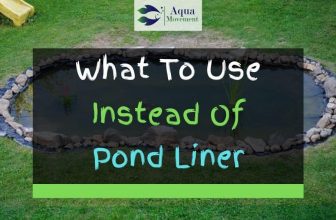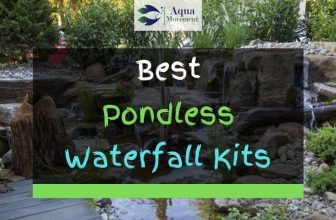Pond Liner: EPDM VS PVC – What’s The Difference?
EPDM pond liner vs PVC pond liners is a common debate, and everyone who wishes to install a private pond goes through one. Does the discussion have a definitive answer?
Unfortunately, no, it doesn’t. Whether you want EPDM or PVC as your pond liner depends on your preferences, requirements, and, most importantly, your budget.
So, create a criterion first. Then, decide which of the two materials fits best for your needs and go with that decision!
But wait, do you have all the necessary information about EPDM and PVC?
If not, don’t worry! Down below is everything you need to know about these materials, including what they are, their pros, and cons.
Read through the guide and choose the best pond liner for yourself!
[amazon table=”13664″]
Table of Contents
What Are Pond Liners?
Video: “How to Measure your Pond Liner”
Before we move onto PVC and EPDM’s precise details, let’s briefly discuss what pond liners are.
A pond liner is exactly what it sounds like; it’s a liner for your pond!
It’s a membrane with impermeable properties and does not allow water to come directly in contact with the soil or ground of your pond. As a result, it prevents the floor from soaking all the water from your pond.
These liners are famous for use in private ponds, artificial streams in gardens and parks, retention basins, reservoirs, etc.
However, remember that a pond liner only does its job best if it’s free of any tears, punctures, and flaws. Thus, you must choose the right material for your liner.
What Is The EPDM Pond Liner?
[amazon box=”B006SOHZBO”]
Ethylene propylene diene monomer, or EPDM, is a form of synthetic rubber and possibly the current most popular material to line ponds worldwide. These liners are incredibly soft but long-lasting.
The fact that they are flexible but tough allows them to stretch out without tearing or losing composure. It means that you can adjust them to different corners and curves.
And the best part is that the liner will still stay flat against the ground and the sides of the pond regardless of how awkwardly you stretch it.
People who have decorative pieces, rocks, and designer ponds usually find EPDM a very suitable option.
Moreover, EPDM doesn’t contract or expand like certain other liner materials. Temperatures, whether high or low, do not affect the material in any way.
However, some think that this characteristic is a drawback considering that you cannot weld the liner. As a result, you will probably have to use adhesives to stick the pieces together.
Despite being soft, EPDM liners are very resistant to ozone, UV rays, and punctures. Plus, they are non-toxic and safe for aquatic species.
Check Price and Reviews on Amazon
- EPDM is exceptionally long-lasting. On average, these liners can last you about 30 years or so.
- This synthetic rubber is relatively less expensive than Butyl while maintaining the same quality and useful features.
- These pond liners are extremely stable, flexible, and aquatic safe.
- EPDM is weather-resistant and does not “age” to become brittle.
- It’s extreme tensile strength and resistance to puncture makes it immensely favorable for designed ponds with decorative features like rough-edged rocks.
- EPDM is more expensive compared to PVC.
- Since EPDM is heavy, it may add to the shipping costs as well.
What Is The PVC Pond Liner?
[amazon box=”B07WRTNMKM”]
While many people think that PVC is only relevant to plumbing, it is also one of the oldest materials for lining ponds.
When it comes to inexpensive pond liners, PVC is the most popular, well-loved option for two reasons: good flexibility at a reasonable price.
Polyvinyl chloride liners are lightweight, puncture-resistant, and significantly pocket-friendly. However, there is more to it.
PVC liners are easy and straightforward to install. You can stick different sheets together and adjust them as your will since they’re pretty flexible.
Like EPDM, PVC sheets can also adapt to tricky nooks and corners of the pond without lifting from the ground or creating any empty spaces underneath. You can seam them, fold them, and they will still not crack!
PVC is a result of extrusion or calendering. It is not a non-reinforced, incredibly waterproof, and highly cost-effective geomembrane. Plus, they were very lightweight compared to EPDM, so they cut the shipping costs by more than half.
Putting different PVC pond liner sheets together and fixing a tear is also very easy. You can spread some glue over the tear and the patch.
Then, wait till the adhesive gets tacky and isn’t wet anymore. Then, put the patch on top of the tear and press it so that both the glued sides become sandwiched.
So, people who want to install and maintain their ponds and pond liners themselves should go with PVC.
Check Price and Reviews on Amazon
- PVC pond liners are the most affordable options.
- Despite the low price, they don’t compromise on flexibility.
- Their flexibility allows you to tape together multiple sheets and adjust them to your pond’s size and shape.
- They are surprisingly resistant to punctures.
- PVC pond liners can last you 20 years or so if properly installed and maintained.
- PVC can become brittle with age. Direct sun exposure, heat, and extreme temperatures can cause the liner to crack over time.
- These pond liners require more maintenance and care.
In Conclusion
As mentioned in the beginning, the debate of EPDM pond liner vs PVC pond liner doesn’t have a definitive answer. Those who want to install and maintain their pond liners themselves should go with PVC.
It’s more user-friendly, easy to install and fix, and requires little professional help. Plus, if you’re on a budget and don’t want to spend on expensive liners, again, PVC is the way to go.
In contrast, if you want a long-lasting liner that is not affected by the weather or extreme temperatures, EPDM will be a better, more suitable choice.
Indeed it is a little more expensive compared to PVC. However, if you consider that they are more durable and weather resistant, and these are priority characteristics for you, a few extra bucks can be completely worth it.
So, depending on your priorities, requirements, and budget, you can pick whatever material seems best to you.




